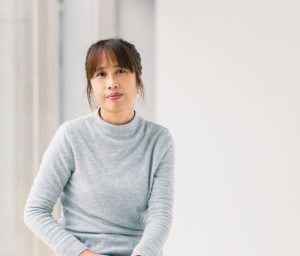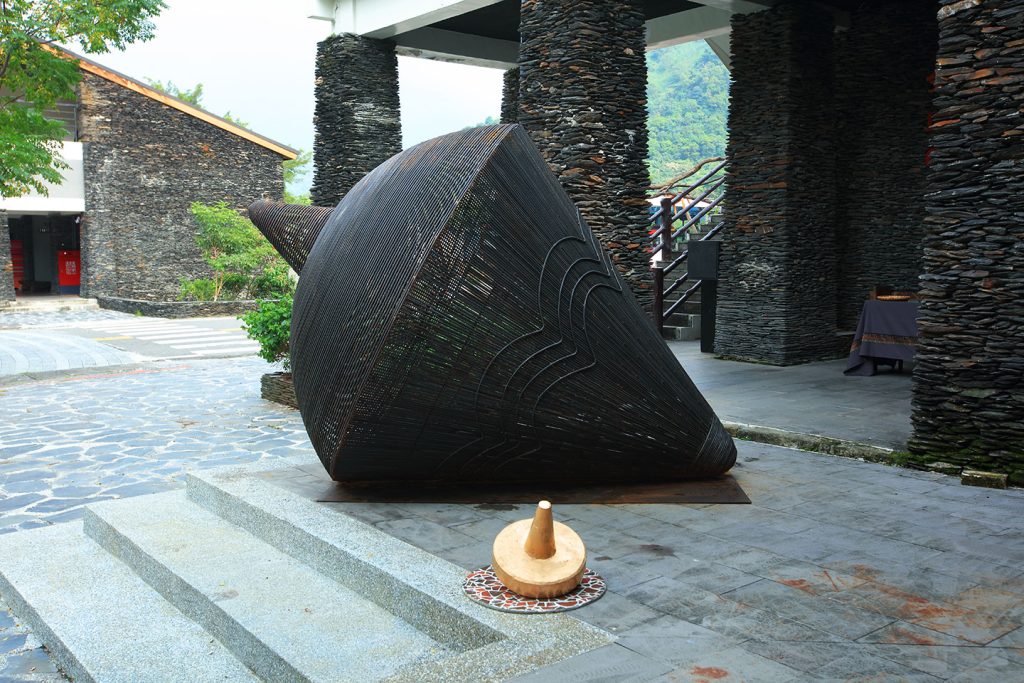
TAIPEI, TAIWAN — Presented by the Indigenous Peoples Cultural Development Center, with the Council of Indigenous Peoples and Ministry of Culture as advisors, the first edition of Taiwan International Austronesian Art Triennial (TIAAT) launched its grand opening on October 28, 2023 at Taiwan Indigenous Culture Park in Pintung, Taiwan, and will open until February 18, 2024.

The Triennial’s theme, “RamiS,” was co-curated by Nakaw Putun and Etan Pavavalung. In response to the theme, the two curators each proposed exhibition subtitles, Becoming Spiritual and Why We Are Us. The inaugural Triennial brings together a total of 25 artists to be showcased in the Octagonal Special Display Hall, Artifact Display Room, and Lifestyle Exhibition Hall, presenting a series of paintings, prints, sculptures, videos, and mixed-media installations. Among the above, the artworks that have recently represented Taiwan in major international exhibitions, including the Biennale of Sydney and Documenta in Kassel, will also be presented for the first time in Taiwan.

Octagonal Special Display Hall
Introductions of the evolution of the Triennial and its participating artists are displayed in this Section to deepen the audience’s understanding of the context of indigenous contemporary art. With the theme of RamiS (“root” in Proto-Austronesian), the Triennial seeks to trace the roots of the Austronesian languages, explore the legends, origins, migration, and expansion, and find answers to the question of the symbiosis between human beings and the nature through art.
Artifact Display Room
Curated by Nakaw Putun, this sub-theme, Becoming Spiritual, explores the beliefs of the indigenous peoples in animism and what it means to be spiritual, and reflects on how human beings can draw on the wisdom of the indigenous peoples to realize a sustainable future.




Exhibited at the Biennale of Sydney 2022, Aluaiy Kaumakan’s Cevulj, Path of a Family is a part of her Rubbings series. Aluaiy began the series in 2014 after returning to the old site of the Paridrayan tribe, which she had left after Typhoon Morakot (August 2009). Combining rubbings and weaving, the work serves as a witness to existence, pointing the way home for people and their souls. Labay Eyong‘s stunning installation Milk and Tear Trails, composed of fibers and recycled steel rebars, demonstrates her delicate approach to weaving and metalwork, while the video People of Cepo illustrates the artist’s faith in weaving and being a nomad. Exhibited at Documenta 2022, Rawus Tjuljaviya’s Snail Paradise Trilogy: Setting Sail or Final Chapter looks into the great exchange of species caused by human travel. Through exploring the route of the African snail invasion, the artist transformed her study of colonialism into paintings on Perspex and embroidered documentation. Tanivu Tapari’s Awakenings series has traced the origins of Austronesian myths and cultivation rituals, such as spinning tops, which was a means of awakening the earth god. The artist therefore used the top to symbolize the creative energy it gives to mankind.




New Zealand artist Lisa Reihana‘s Nomads of the Sea not only examines the European narrative of colonial history in the Pacific but also rethinks the traditional culture and gender values of the Maori people. Selected to participate in the upcoming Biennale of Sydney 2024, Idas Losin responds to the Tahitian women often seen in Paul Gauguin’s paintings with portraits of indigenous Taiwanese men, exploring a perspective different from that of the West. Ciwas Tahos’s Finding Pathways to Temahahoi series reinterprets the narrative possibilities of land, identity, women, and queer bodies through the process of tracing the locations of wild bees. Dondon Hounwn‘s creations are all in response to Gaya (“law of the universe” or “norm of the life” in the Taroko language). The video installation BBRBAR-2.0 explores how the Taroko people can still hear the small voice of the survival of traditional values in the changing times.




Reretan Pavavaljung’s paintings from the Innumerable Differences, One World series incorporate humans and animals, technology, and the primitive in a depiction of how people must first go on a bizarre journey before becoming spirits. Iyo Kacaw‘s creations often convey the perception of the body in the sea. His wood sculpture Between You and Me explores how the ocean has been destroyed, yet endlessly comforts mankind. Lafin Sawmah (1983-2023) used boat building as a pious and eternal path of action, opening a window for dialogue between the Austronesian peoples and the world. The Triennial will present a series of ocean-themed works by Lafin in recent years to commemorate the late artist who was deeply devoted to Austronesian art.




Lifestyle Exhibition Hall
Curated by Etan Pavavalung, the sub-theme Why We Are Us is centered on Austronesian rituals of life, myths, languages, cultures, motifs, eco-philosophies, and stories of migration, with the aim of spurring dialogue, to understand common historical memory and to convey the relationship of mankind and nature.




Viewers are greeted by I Made Sukariawan’s large-scale work Barong. Entering the exhibition space through the mouth of the Barong lion, visitors open the Indonesian Balinese-style wooden door, which symbolizes entering the artistic realm of the artisan family. Milay Mavaliw’s Dalan series of installations and paintings features intertwined, woven hemp-colored materials that are suspended from above and cascade down to scatter across the floor. This visual metaphor establishes connections between islands, symbolizing the millennia-long historical ties of the Austronesian people. As part of her 50-year creative plan, Yuma Taru’s Sea·Rise and River·Flow are both weaving installations that reflect her recent studies and observations on issues shared by Austronesian communities. Sya man Misrako recreated a beachside in the exhibition space and installed it with wooden canoes suspended and placed upon the sand. The arrangement evokes how Austronesian maritime societies acquire cultural significance from the sea, forming footprints that make up the broader Austronesian narrative.



Ljailjai Tult installed seven colossal wooden figures next to the traditional slate house, an existing feature of the exhibition hall. Arranged in a linear progression, these figures gaze in a unified direction, pointing towards the past and the future of the Austronesian people. Through a fusion of Bunun literature and artistic expression, Ali Istanda’s After the Flood, There Are Islands explores human connections with islands, oceanic environments, and interpersonal relationships. Drawing inspiration from the Seediq’s folklore of the Sisin bird (Grey-cheeked fulvetta), Siyat Moses employs the figure of Sisin traversing seven circles as the central motif. Created through silk printing interwoven with textile and mixed media, these circles symbolize that Sisin’s traditional significance remains intertwined in modern culture. Ljaljeqelan Patadalj and Sutipau Tjaruzaljum employ video, hand-weaving, and mixed media in their installation to delve into topics of migration and return. They seek pathways for reclaiming the identity of the new generation. Anguc Makaunamun’s Memory Tablet series offers a reinterpretation of indigenous identities adrift between their homeland and urban settings. His Among Beast Heads series rearranges human, animal, and plant features, conceiving new totemic symbols and establishing new connections between human beings and the environment.
Kulele Ruladen’s Forms of Ancestral Spirits takes fire as the concept, converting this ancient energy into a modern electrical force that continues to drive progress, depicting how the wisdom and beliefs of our ancestors can manifest in a modern form. Tuwak Tuyaw and Chen, Shu-yen use driftwood combined with bark and fibers to create designs resembling boats, islands, fruits, and seeds. These designs symbolize fluidity, navigation, and dissemination, echoing the Out of Taiwan Hypothesis about Austronesian origins. Chee Wai Loong‘s dynamic mechanical installation “Homesick” uses the lighthouse as a symbolic image. The artist situates a traditional Malaysian stage house in the center of the sea, its rooftop adorned by a Malaysian kite. Through the drifting forms, the sound waves, and the play of light and shadow, the artist hopes to facilitate a destined reunion between the ancestors and the us of today.
The TIAAT forum will be held on October 29, featuring co-curators Nakaw Putun and Etan Pavavalung, exhibition consultants Gong Jow-Jiun and Tung Yuan-chao, participating artists and international curators including Reuben Keehan, Zara Stanhope, Hsu Manray, Pan Sheau-shei, Kao Jun-honn, Chen, Horng-yi, Lin Yu-shih. This forum aims to bring together the international panellists’ perspectives, and museum experiences and explore the future of indigenous contemporary art. The Triennial exhibition book RamiS – Taiwan International Austronesian Art Triennial is being simultaneously published, which includes the introduction of participating artists, artwork descriptions, and installation photos.





For more information, please see www.tacp.gov.tw and tiaat.tacp.gov.tw








